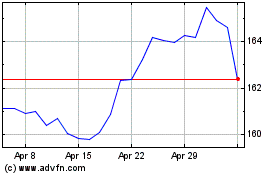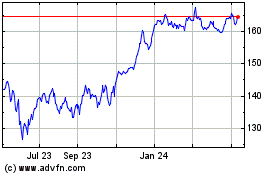T-Mobile Overtakes AT&T As No. 2 -- WSJ
August 07 2020 - 3:02AM
Dow Jones News
By Drew FitzGerald
This article is being republished as part of our daily
reproduction of WSJ.com articles that also appeared in the U.S.
print edition of The Wall Street Journal (August 7, 2020).
T-Mobile US Inc. said it vaulted ahead of rival AT&T Inc. in
the race for wireless customers to become the country's
second-largest cellphone carrier.
The Bellevue, Wash., company ended June with 98.3 million U.S.
customers, excluding wholesale subscribers on other brands that use
its network. AT&T reported 92.9 million prepaid and postpaid
customers, a tally that didn't count wholesale accounts or
connected devices such as Wi-Fi hotspots and car sensors. T-Mobile
included non-phone gadgets like wireless hotspots in its reported
customer base.
Despite the different reporting policies, T-Mobile was long
expected to climb the wireless rankings after it closed its merger
with rival Sprint in April. The merger effort prevailed after a
more than two-year battle with regulators and antitrust enforcers
that culminated in a federal antitrust trial brought by a coalition
of state officials. The transaction created a larger mobile service
provider with a market value topping $100 billion controlled by
German parent company Deutsche Telekom AG.
"We're staring down Verizon with our sight set on the No. 1
spot," T-Mobile Chief Executive Mike Sievert said Thursday during a
videoconference with financial analysts. Verizon Communications
Inc. ended June with 119.9 million wireless connections, a figure
that also counted smartwatches, tablets, and other machines aside
from smartphones.
T-Mobile's second-quarter results showed it also weathered the
coronavirus pandemic better than its competitors, adding 253,000
postpaid phone customers during the period. Investors place a
higher value on postpaid customers -- who are billed for service
after it is rendered -- than on prepaid plans subject to more
customer switches.
Overall, T-Mobile reported a second-quarter profit of $110
million, down from $939 million a year earlier before it had
acquired Sprint. The result included $798 million of pretax merger
costs. Revenue jumped to $17.7 billion, up 61% from about $11
billion a year earlier, when T-Mobile was a stand-alone
carrier.
Executives warned investors to expect higher-than-usual costs in
the second half, including between $800 million and $1 billion in
merger-related expenses. T-Mobile decommissioned the Sprint brand
earlier this week and continues to close some of its former
competitor's stores while it merges the two companies' networks, a
multiyear process.
Write to Drew FitzGerald at andrew.fitzgerald@wsj.com
(END) Dow Jones Newswires
August 07, 2020 02:47 ET (06:47 GMT)
Copyright (c) 2020 Dow Jones & Company, Inc.
T Mobile US (NASDAQ:TMUS)
Historical Stock Chart
From Aug 2024 to Sep 2024

T Mobile US (NASDAQ:TMUS)
Historical Stock Chart
From Sep 2023 to Sep 2024
